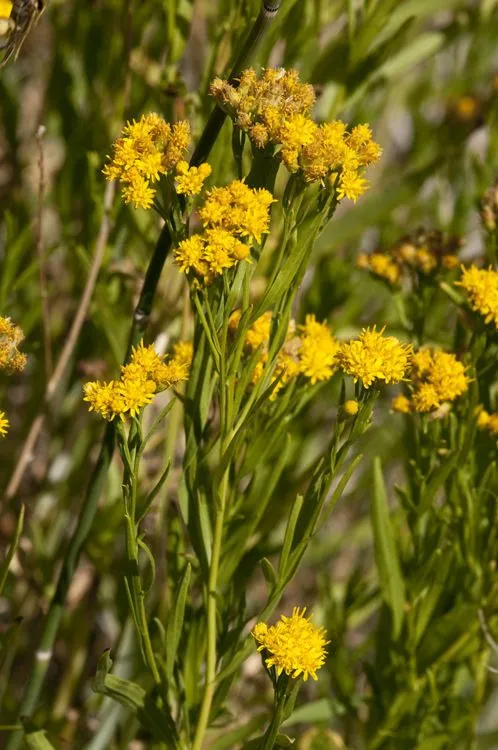
Author: Nutt.
Bibliography: Trans. Amer. Philos. Soc., ser. 2, 7: 326 (1840)
Year: 1840
Status: accepted
Rank: species
Genus: Euthamia
Vegetable: False
Observations: SW. Canada to Mexico (N. Baja California Norte)
Western-goldenrod, known scientifically as Euthamia occidentalis, is a perennial herbaceous plant belonging to the family Asteraceae. This species was first described by Nutt. in a detailed scientific work published in the Transactions of the American Philosophical Society in 1840.
The plant is endemic to regions stretching from southwestern Canada through the western United States and into northern Baja California in Mexico. This wide geographical range underscores its adaptability to various environments within North America.
Characterized by its bright yellow flowers, Western-goldenrod blooms from late summer into fall, adding a splash of color to the landscape during these months. The flowers are typically small and clustered, attracting a variety of pollinators, including bees and butterflies, which play a crucial role in the ecosystem by facilitating cross-pollination.
Western-goldenrod thrives in diverse habitats, often found in open fields, prairies, along roadsides, and in wetlands. Its preference for well-drained soils and sunny locations makes it relatively easy to grow, provided these conditions are met. The plant’s hardiness also allows it to be an excellent choice for natural landscaping and restoration projects aiming to support local biodiversity.
In addition to its ecological value, Western-goldenrod has been used in traditional medicine by various indigenous cultures, who valued it for its purported medicinal properties. Although not widely used in modern herbal practices, these historical applications highlight the plant’s significance to past communities.
Overall, Western-goldenrod is an important species within the Asteraceae family, notable for its vibrant blooms and ecological utility. Its extensive natural range and adaptability to different environments make it a resilient and valued component of native floral communities across its distribution area.
Eng: western goldentop, western-goldenrod, western goldenrod, western fragrant goldenrod
Fra: verge d’or de l’ouest
En: Western-goldenrod, Western goldentop, WESTERN GOLDENROD, Western fragrant goldenrod
Fr: Verge d’or de l’Ouest
Taken Dec 14, 2008 by EOL − Keir Morse (cc-by-nc-sa)
Taken Nov 15, 2012 by EOL − Steve Matson (cc-by-nc)
Taken Nov 15, 2012 by EOL − Steve Matson (cc-by-nc)
Taken Nov 15, 2012 by EOL − Steve Matson (cc-by-nc)
Taken Oct 28, 2013 by EOL − Steve Matson (cc-by-nc)
Taken Aug 23, 2022 by Ross Kat (cc-by-sa)
Taken Aug 23, 2022 by Ross Kat (cc-by-sa)
Taken Aug 23, 2022 by Ross Kat (cc-by-sa)
Taken Feb 21, 2008 by EOL − Keir Morse (cc-by-nc-sa)
Taken Jul 29, 2022 by Sierra Johnston (cc-by-sa)
Taken Feb 16, 2015 by EOL − Richard Spellenberg (cc-by-nc-sa)
Taken Aug 31, 2014 by EOL − Mary Winter (public)
Taken Nov 15, 2012 by EOL − Steve Matson (cc-by-nc)
Taken Nov 15, 2012 by EOL − Steve Matson (cc-by-nc)
Taken Oct 28, 2013 by EOL − Steve Matson (cc-by-nc)
Taken Oct 25, 2008 by EOL − Zoya Akulova (cc-by-nc)
© copyright of the Board of Trustees of the Royal Botanic Gardens, Kew.
Growth form>: Rhizomatous
Growth habit>: Forb/herb
Growth rate>: Moderate
Ph maximum: 7.0
Ph minimum: 4.5
Family: Myrtaceae Author: (F.Muell.) K.D.Hill & L.A.S.Johnson Bibliography: Telopea 6: 402 (1995) Year: 1995 Status:…
Family: Rubiaceae Author: Pierre ex A.Froehner Bibliography: Notizbl. Bot. Gart. Berlin-Dahlem 1: 237 (1897) Year:…
Family: Sapindaceae Author: Koidz. Bibliography: J. Coll. Sci. Imp. Univ. Tokyo 32(1): 38 (1911) Year:…
Family: Asteraceae Author: A.Gray Bibliography: Pacif. Railr. Rep.: 107 (1857) Year: 1857 Status: accepted Rank:…
Family: Fabaceae Author: Medik. Bibliography: Vorles. Churpfälz. Phys.-Ökon. Ges. 2: 398 (1787) Year: 1787 Status:…
Family: Aspleniaceae Author: (Cav.) Alston Bibliography: Bull. Misc. Inform. Kew 1932: 309 (1932) Year: 1932…